#Native Indian Wisdom
Explore tagged Tumblr posts
Text
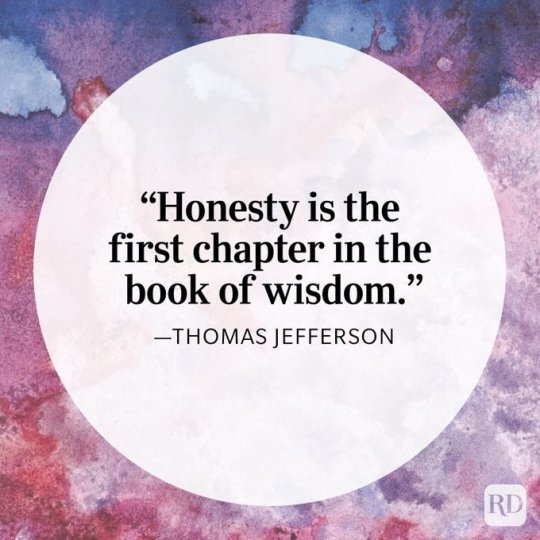
#wisdom#bettertomorrows#goldennuggets#native american woman rituals#spirituality#faith#healing#indian men#inspiration#mindfulness#youtube#freedom of mind#mindset
13 notes
·
View notes
Text

Braiding Sweetgrass: Indigenous Wisdom, Scientific Knowledge, and the Teachings of Plants, by Robin Wall Kimmerer
#Robin Wall Kimmerer#Braiding Sweetgrass: Indigenous Wisdom#Scientific Knowledge#and the Teachings of Plants#robin wall kimmerer braiding sweetgrass#braiding sweetgrass#braiding sweetgrass book#book#books#quote#quotes#indian#native american#indigenous quotes#indigenous#american indian#book quote#ecological#ecological restoration#restoration#nature#science#indigenous environmental network#environment#environmental#environmental quote#indigenous peoples#environmental science
8 notes
·
View notes
Text
lmao why are we still making and sharing "two wolves" memes it's almost 2023 and that format of meme is RACIST
#yes im talking about the one for Wednesday on netflix#two wolves#racism#casual racism#ofc if indigenous people say it then it gets ignored#billy graham used to tell that shit on stage as “indian wisdom” to wow his colonizer audience#indigenous#native tumblr
2 notes
·
View notes
Photo










(via " BLUE RED YELLOW ABSTRACT PAINTING NATIVE AMERICAN TRIBAL ART PATTERN " Metal Print for Sale by Frantz CIALEC)
#findyourthing#redbubble#art vs artist#raleksd#native#nativeamericans#inigenous#native american indian#the tribal chief#tribal art#totem#pattern#chief indian#feathers#navajo#sioux#warrior#native wisdom
0 notes
Video
youtube
Life-Changing Native American Proverbs: Embracing Wisdom from the Past
#youtube#quotes about life#quotes channel#native american tribes#native american words of wisdom#american indian proverbs#native american proverb two wolves#native american quotes and proverbs#native american proverb death#timeless native american proverbs#american proverbs#proverbs#native american proverb#native american quotes#native american wisdom#native american#native american proverbs
0 notes
Text
Reading list for Afro-Herbalism:
A Healing Grove: African Tree Remedies and Rituals for the Body and Spirit by Stephanie Rose Bird
Affrilachia: Poems by Frank X Walker
African American Medicine in Washington, D.C.: Healing the Capital During the Civil War Era by Heather Butts
African American Midwifery in the South: Dialogues of Birth, Race, and Memory by Gertrude Jacinta Fraser
African American Slave Medicine: Herbal and Non-Herbal Treatments by Herbert Covey
African Ethnobotany in the Americas edited by Robert Voeks and John Rashford
Africanisms in the Gullah Dialect by Lorenzo Dow Turner
Africans and Native Americans: The Language of Race and the Evolution of Red-Black Peoples by Jack Forbes
African Medicine: A Complete Guide to Yoruba Healing Science and African Herbal Remedies by Dr. Tariq M. Sawandi, PhD
Afro-Vegan: Farm-Fresh, African, Caribbean, and Southern Flavors Remixed by Bryant Terry
Barracoon: The Story of the Last “Black Cargo” by Zora Neale Hurston
Big Mama’s Back in the Kitchen by Charlene Johnson
Big Mama’s Old Black Pot by Ethel Dixon
Black Belief: Folk Beliefs of Blacks in America and West Africa by Henry H. Mitchell
Black Diamonds, Vol. 1 No. 1 and Vol. 1 Nos. 2–3 edited by Edward J. Cabbell
Black Faces, White Spaces: Reimagining the Relationship of African Americans to the Great Outdoors by Carolyn Finney
Black Food Geographies: Race, Self-Reliance, and Food Access in Washington, D.C. by Ashanté M. Reese
Black Indian Slave Narratives edited by Patrick Minges
Black Magic: Religion and the African American Conjuring Tradition by Yvonne P. Chireau
Black Nature: Four Centuries of African American Nature Poetry edited by Camille T. Dungy
Blacks in Appalachia edited by William Turner and Edward J. Cabbell
Caribbean Vegan: Meat-Free, Egg-Free, Dairy-Free Authentic Island Cuisine for Every Occasion by Taymer Mason
Dreams of Africa in Alabama: The Slave Ship Clotilda and the Story of the Last Africans Brought to America by Sylviane Diouf
Faith, Health, and Healing in African American Life by Emilie Townes and Stephanie Y. Mitchem
Farming While Black: Soul Fire Farm’s Practical Guide to Liberation on the Land by Leah Penniman
Folk Wisdom and Mother Wit: John Lee – An African American Herbal Healer by John Lee and Arvilla Payne-Jackson
Four Seasons of Mojo: An Herbal Guide to Natural Living by Stephanie Rose Bird
Freedom Farmers: Agricultural Resistance and the Black Freedom Movement by Monica White
Fruits of the Harvest: Recipes to Celebrate Kwanzaa and Other Holidays by Eric Copage
George Washington Carver by Tonya Bolden
George Washington Carver: In His Own Words edited by Gary Kremer
God, Dr. Buzzard, and the Bolito Man: A Saltwater Geechee Talks About Life on Sapelo Island, Georgia by Cornelia Bailey
Gone Home: Race and Roots through Appalachia by Karida Brown
Ethno-Botany of the Black Americans by William Ed Grime
Gullah Cuisine: By Land and by Sea by Charlotte Jenkins and William Baldwin
Gullah Culture in America by Emory Shaw Campbell and Wilbur Cross
Gullah/Geechee: Africa’s Seeds in the Winds of the Diaspora-St. Helena’s Serenity by Queen Quet Marquetta Goodwine
High on the Hog: A Culinary Journey from Africa to America by Jessica Harris and Maya Angelou
Homecoming: The Story of African-American Farmers by Charlene Gilbert
Hoodoo Medicine: Gullah Herbal Remedies by Faith Mitchell
Jambalaya: The Natural Woman’s Book of Personal Charms and Practical Rituals by Luisah Teish
Just Medicine: A Cure for Racial Inequality in American Health Care by Dayna Bowen Matthew
Leaves of Green: A Handbook of Herbal Remedies by Maude E. Scott
Like a Weaving: References and Resources on Black Appalachians by Edward J. Cabbell
Listen to Me Good: The Story of an Alabama Midwife by Margaret Charles Smith and Linda Janet Holmes
Making Gullah: A History of Sapelo Islanders, Race, and the American Imagination by Melissa Cooper
Mandy’s Favorite Louisiana Recipes by Natalie V. Scott
Medical Apartheid: The Dark History of Medical Experimentation on Black Americans from Colonial Times to the Present by Harriet Washington
Mojo Workin’: The Old African American Hoodoo System by Katrina Hazzard-Donald
Motherwit: An Alabama Midwife’s Story by Onnie Lee Logan as told to Katherine Clark
My Bag Was Always Packed: The Life and Times of a Virginia Midwife by Claudine Curry Smith and Mildred Hopkins Baker Roberson
My Face Is Black Is True: Callie House and the Struggle for Ex-Slave Reparations by Mary Frances Berry
My Grandmother's Hands: Racialized Trauma and the Pathway to Mending Our Hearts and Bodies by Resmaa Menakem
On Her Own Ground: The Life and Times of Madam C.J. Walker by A'Lelia Bundles
Papa Jim’s Herbal Magic Workbook by Papa Jim
Places for the Spirit: Traditional African American Gardens by Vaughn Sills (Photographer), Hilton Als (Foreword), Lowry Pei (Introduction)
Post Traumatic Slave Syndrome by Dr. Joy DeGruy
Rooted in the Earth: Reclaiming the African American Environmental Heritage by Diane Glave
Rufus Estes’ Good Things to Eat: The First Cookbook by an African-American Chef by Rufus Estes
Secret Doctors: Ethnomedicine of African Americans by Wonda Fontenot
Sex, Sickness, and Slavery: Illness in the Antebellum South by Marli Weiner with Mayzie Hough
Slavery’s Exiles: The Story of the American Maroons by Sylviane Diouf
Soul Food: The Surprising Story of an American Cuisine, One Plate at a Time by Adrian Miller
Spirituality and the Black Helping Tradition in Social Work by Elmer P. Martin Jr. and Joanne Mitchell Martin
Sticks, Stones, Roots & Bones: Hoodoo, Mojo & Conjuring with Herbs by Stephanie Rose Bird
The African-American Heritage Cookbook: Traditional Recipes and Fond Remembrances from Alabama’s Renowned Tuskegee Institute by Carolyn Quick Tillery
The Black Family Reunion Cookbook (Recipes and Food Memories from the National Council of Negro Women) edited by Libby Clark
The Conjure Woman and Other Conjure Tales by Charles Chesnutt
The Home Place: Memoirs of a Colored Man’s Love Affair with Nature by J. Drew Lanham
The Jemima Code: Two Centuries of African American Cookbooks by Toni Tipton-Martin
The President’s Kitchen Cabinet: The Story of the African Americans Who Have Fed Our First Families, from the Washingtons to the Obamas by Adrian Miller
The Taste of Country Cooking: The 30th Anniversary Edition of a Great Classic Southern Cookbook by Edna Lewis
The Tuskegee Syphilis Study: An Insiders’ Account of the Shocking Medical Experiment Conducted by Government Doctors Against African American Men by Fred D. Gray
Trace: Memory, History, Race, and the American Landscape by Lauret E. Savoy
Vegan Soul Kitchen: Fresh, Healthy, and Creative African-American Cuisine by Bryant Terry
Vibration Cooking: Or, The Travel Notes of a Geechee Girl by Vertamae Smart-Grosvenor
Voodoo and Hoodoo: The Craft as Revealed by Traditional Practitioners by Jim Haskins
When Roots Die: Endangered Traditions on the Sea Islands by Patricia Jones-Jackson
Working Conjure: A Guide to Hoodoo Folk Magic by Hoodoo Sen Moise
Working the Roots: Over 400 Years of Traditional African American Healing by Michelle Lee
Wurkn Dem Rootz: Ancestral Hoodoo by Medicine Man
Zora Neale Hurston: Folklore, Memoirs, and Other Writings: Mules and Men, Tell My Horse, Dust Tracks on a Road, Selected Articles by Zora Neale Hurston
The Ways of Herbalism in the African World with Olatokunboh Obasi MSc, RH (webinar via The American Herbalists Guild)
2K notes
·
View notes
Text












Native Knowledge
Medicine Generations: Natural Native American Medicines Traditional to the Stockbridge-Munsee Band of Mohicans Indian Tribe, published in 2013, is part of our Native American Literature Collection. Misty Cook (Davids), M. S., of the Stockbridge-Munsee Community, wrote the book and is also credited with the photography.
The Stockbridge-Munsee Community, a band of the Mohican Indian Tribe, has a profound cultural heritage that has always placed a strong emphasis on traditional medicine. For generations, the knowledge of plant medicine has been passed down as an oral tradition that traces its roots back to the native lands of both Mohican and Munsee ancestors. Jeanette "Granny" Gardner, Cook's ancestor, is responsible for keeping much of this knowledge alive.
This knowledge comes together in her book, which contains 58 Native American herbal medicines. It serves as a guide to learning about and how to use the Medicines, and it also includes the history of the Medicines as passed down through her family's lineage of Wolf Clan Medicine people. At its core, this book is a testament to the resilience and wisdom of the Stockbridge-Munsee Community. It stands as a vital document, preserving and sharing the invaluable knowledge of traditional Native American medicinal practices for future generations in the community and beyond.
View other posts from our Native American Literature Collection.
-Melissa (Stockbridge-Munsee), Special Collections Graduate Intern
#native americans#native american women#stockbride-munsee#mohican#munsee#native plants#medicine#misty cook#medicine generations#Jeanette “Granny” Gardner#traditional medicine#indigenous#native american traditions#mohican indian tribe#plant medicine#oral traditions#herbal medicines#ancestors#native american literature collection
88 notes
·
View notes
Photo
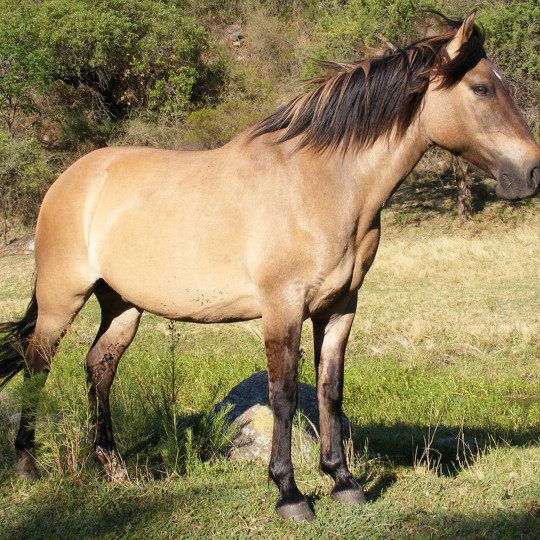
The Dun Horse
The Dun Horse is a Pawnee tale about a poor boy and his grandmother, who find an old horse and take it in. The horse turns out to be magical, however, and improves their fortunes considerably. Like many Pawnee legends – and Native American tales generally – the story highlights the importance of kindness and of following instructions.
In Pawnee spiritual belief, the Great Spirit was the Creator God Ti-ra'wa ("Father Above"), who, despite any evidence to the contrary, was always in control of the created world. Aspects of the world that one judged to be "good" or "bad" were only so in one's opinion as no "bad" thing could come from Ti-ra'wa. The wisdom of the elders, and of the natural world, was understood to come from this same source, and so there are many stories of talking animals, or of elder characters, providing instruction which one ignored at one's peril.
In many stories, including the Wihio tales of the Cheyenne and the Iktomi tales of the Sioux, failing to follow instructions leads to failure – or even death – while, in The Dun Horse, the central character is given a second chance by Ti-ra'wa after his failure, learns from his mistake, and is rewarded for his kindness, faithfulness, and courage.
Text
The following is taken from Pawnee Hero Stories and Folk-Tales (1889) by George Bird Grinnell. As in many Native American tales, the number four is repeated as it is understood as sacred, representing the cardinal points of the compass and the spirits who preside over the directions.
I.
Many years ago, there lived in the Pawnee tribe an old woman and her grandson, a boy about sixteen years old. These people had no relations and were very poor. They were so poor that they were despised by the rest of the tribe. They had nothing of their own; and always, after the village started to move the camp from one place to another, these two would stay behind the rest, to look over the old camp, and pick up anything that the other Indians had thrown away, as worn out or useless. In this way they would sometimes get pieces of robes, worn out moccasins with holes in them, and bits of meat.
Now, it happened one day, after the tribe had moved away from the camp, that this old woman and her boy were following along the trail behind the rest, when they came to a miserable old worn-out dun horse, which they supposed had been abandoned by some Indians. He was thin and exhausted, was blind of one eye, had a bad sore back, and one of his forelegs was very much swollen. In fact, he was so worthless that none of the Pawnees had been willing to take the trouble to try to drive him along with them. But when the old woman and her boy came along, the boy said, "Come now, we will take this old horse, for we can make him carry our pack." So, the old woman put her pack on the horse, and drove him along, but he limped and could only go very slowly.
II.
The tribe moved up on the North Platte, until they came to Court House Rock. The two poor Indians followed them and camped with the others. One day while they were here, the young men who had been sent out to look for buffalo, came hurrying into camp and told the chiefs that a large herd of buffalo were near, and that among them was a spotted calf.
The Head Chief of the Pawnees had a very beautiful daughter, and when he heard about the spotted calf, he ordered his old crier to go about through the village and call out that the man who killed the spotted calf should have his daughter for his wife. For a spotted robe is ti-war´-uks-ti—big medicine .
The buffalo were feeding about four miles from the village, and the chiefs decided that the charge should be made from there. In this way, the man who had the fastest horse would be the most likely to kill the calf. Then all the warriors and the young men picked out their best and fastest horses and made ready to start. Among those who prepared for the charge was the poor boy on the old dun horse. But when they saw him, all the rich young braves on their fast horses pointed at him, and said, "Oh, see; there is the horse that is going to catch the spotted calf;" and they laughed at him, so that the poor boy was ashamed, and rode off to one side of the crowd, where he could not hear their jokes and laughter.
When he had ridden off some little way, the horse stopped, and turned his head round, and spoke to the boy. He said, "Take me down to the creek, and plaster me all over with mud. Cover my head and neck and body and legs." When the boy heard the horse speak, he was afraid; but he did as he was told. Then the horse said, "Now mount, but do not ride back to the warriors, who laugh at you because you have such a poor horse. Stay right here, until the word is given to charge." So, the boy stayed there.
And presently all the fine horses were drawn up in line and pranced about and were so eager to go that their riders could hardly hold them in; and at last, the old crier gave the word, "Loo-ah"—Go! Then the Pawnees all leaned forward on their horses and yelled, and away they went. Suddenly, away off to the right, was seen the old dun horse. He did not seem to run. He seemed to sail along like a bird. He passed all the fastest horses, and in a moment, he was among the buffalo. First, he picked out the spotted calf, and charging up alongside of it, U-ra-rish! straight flew the arrow. The calf fell. The boy drew another arrow and killed a fat cow that was running by. Then he dismounted and began to skin the calf before any of the other warriors had come up. But when the rider got off the old dun horse, how changed he was! He pranced about and would hardly stand still near the dead buffalo. His back was all right again; his legs were well and fine; and both his eyes were clear and bright.
The boy skinned the calf and the cow that he had killed, and then he packed all the meat on the horse and put the spotted robe on top of the load, and started back to the camp on foot, leading the dun horse. But even with this heavy load the horse pranced all the time and was no longer scared at everything he saw. On the way to camp, one of the rich young chiefs of the tribe rode up by the boy and offered him twelve good horses for the spotted robe, so that he could marry the Head Chief's beautiful daughter; but the boy laughed at him and would not sell the robe.
Now, while the boy walked to the camp leading the dun horse, most of the warriors rode back, and one of those that came first to the village, went to the old woman, and said to her, "Your grandson has killed the spotted calf." And the old woman said, "Why do you come to tell me this? You ought to be ashamed to make fun of my boy because he is poor." The warrior said, "What I have told you is true," and then he rode away. After a little while another brave rode up to the old woman, and said to her, "Your grandson has killed the spotted calf." Then the old woman began to cry, she felt so badly because everyone made fun of her boy, because he was poor.
Pretty soon the boy came along, leading the horse up to the lodge where he and his grandmother lived. It was a little lodge, just big enough for two, and was made of old pieces of skin that the old woman had picked up and was tied together with strings of rawhide and sinew. It was the meanest and worst lodge in the village. When the old woman saw her boy leading the dun horse with the load of meat and the robes on it, she was very much surprised. The boy said to her, "Here, I have brought you plenty of meat to eat, and here is a robe, that you may have for yourself. Take the meat off the horse." Then the old woman laughed, for her heart was glad. But when she went to take the meat from the horse's back, he snorted and jumped about, and acted like a wild horse. The old woman looked at him in wonder and could hardly believe that it was the same horse. So, the boy had to take off the meat, for the horse would not let the old woman come near him.
III.
That night the horse spoke again to the boy and said, "Wa-ti-hes Chah´-ra-rat wa-ta. To-morrow the Sioux are coming—a large war party. They will attack the village, and you will have a great battle. Now, when the Sioux are drawn up in line of battle, and are all ready to fight, you jump on to me, and ride as hard as you can, right into the middle of the Sioux, and up to their Head Chief, their greatest warrior, and count coup on him, and kill him, and then ride back. Do this four times, and count coup on four of the bravest Sioux, and kill them, but don't go again. If you go the fifth time, maybe you will be killed, or else you will lose me. La-ku´-ta-chix—remember." So, the boy promised.
The next day it happened as the horse had said, and the Sioux came down and formed a line of battle. Then the boy took his bow and arrows, and jumped on the dun horse, and charged into the midst of them. And when the Sioux saw that he was going to strike their Head Chief, they all shot their arrows at him, and the arrows flew so thickly across each other that the sky became dark, but none of them hit the boy. And he counted coup on the Chief, and killed him, and then rode back. After that he charged again among the Sioux, where they were gathered thickest, and counted coup on their bravest warrior, and killed him. And then twice more, until he had gone four times as the horse had told him.
But the Sioux and the Pawnees kept on fighting, and the boy stood around and watched the battle. And at last, he said to himself, "I have been four times and have killed four Sioux, and I am all right, I am not hurt anywhere; why may I not go again?" So, he jumped on the dun horse, and charged again. But when he got among the Sioux, one Sioux warrior drew an arrow and shot. The arrow struck the dun horse behind the forelegs and pierced him through. And the horse fell down dead. But the boy jumped off, and fought his way through the Sioux, and ran away as fast as he could to the Pawnees. Now, as soon as the horse was killed, the Sioux said to each other, "This horse was like a man. He was brave. He was not like a horse." And they took their knives and hatchets, and hacked the dun horse and gashed his flesh, and cut him into small pieces.
The Pawnees and Sioux fought all day long, but toward night the Sioux broke and fled.
IV.
The boy felt very badly that he had lost his horse; and, after the fight was over, he went out from the village to where it had taken place, to mourn for his horse. He went to the spot where the horse lay, and gathered up all the pieces of flesh, which the Sioux had cut off, and the legs and the hoofs, and put them all together in a pile. Then he went off to the top of a hill nearby and sat down and drew his robe over his head and began to mourn for his horse.
As he sat there, he heard a great windstorm coming up, and it passed over him with a loud rushing sound, and after the wind came a rain. The boy looked down from where he sat to the pile of flesh and bones, which was all that was left of his horse, and he could just see it through the rain. And the rain passed by, and his heart was very heavy, and he kept on mourning.
And pretty soon, came another rushing wind, and after it a rain; and as he looked through the driving rain toward the spot where the pieces lay, he thought that they seemed to come together and take shape, and that the pile looked like a horse lying down, but he could not see well for the thick rain.
After this, came a third storm like the others; and now when he looked toward the horse, he thought he saw its tail move from side to side two or three times, and that it lifted its head from the ground. The boy was afraid, and wanted to run away, but he stayed.
And as he waited, there came another storm. And while the rain fell, looking through the rain, the boy saw the horse raise himself up on his forelegs and look about. Then the dun horse stood up.
V.
The boy left the place where he had been sitting on the hilltop and went down to him. When the boy had come near to him, the horse spoke and said, "You have seen how it has been this day; and from this you may know how it will be after this. But Ti-ra´-wa has been good and has let me come back to you. After this, do what I tell you; not any more, not any less." Then the horse said, "Now lead me off, far away from the camp, behind that big hill, and leave me there to-night, and in the morning come for me;" and the boy did as he was told.
And when he went for the horse in the morning, he found with him a beautiful white gelding, much more handsome than any horse in the tribe. That night the dun horse told the boy to take him again to the place behind the big hill, and to come for him the next morning; and when the boy went for him again, he found with him a beautiful black gelding. And so for ten nights, he left the horse among the hills, and each morning he found a different colored horse, a bay, a roan, a gray, a blue, a spotted horse, and all of them finer than any horses that the Pawnees had ever had in their tribe before.
Now the boy was rich, and he married the beautiful daughter of the Head Chief, and when he became older, he was made Head Chief himself. He had many children by his beautiful wife, and one day when his oldest boy died, he wrapped him in the spotted calf robe and buried him in it. He always took good care of his old grandmother and kept her in his own lodge until she died. The dun horse was never ridden except at feasts, and when they were going to have a doctors' dance, but he was always led about with the Chief, wherever he went. The horse lived in the village for many years, until he became very old. And at last, he died.
Continue reading...
75 notes
·
View notes
Text
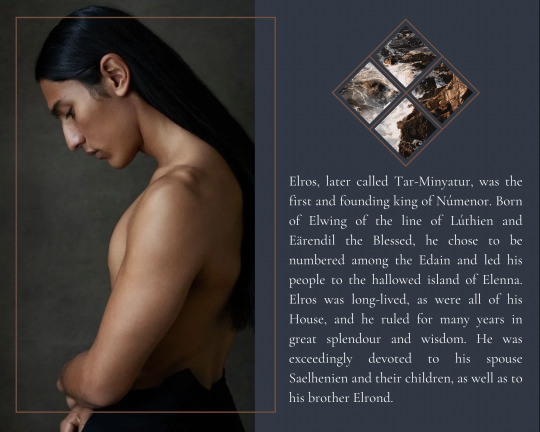

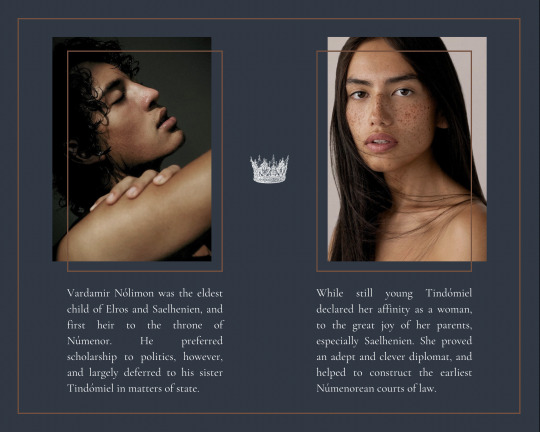
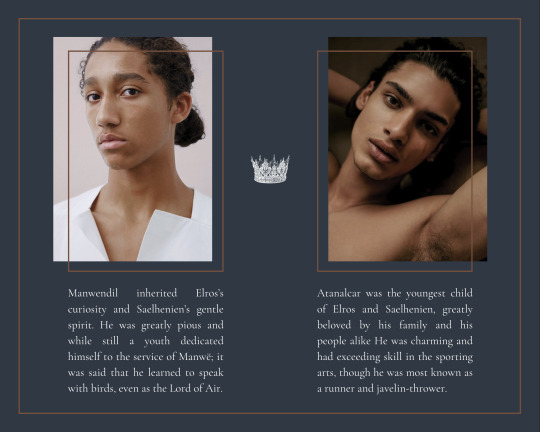
"But to Elros, who chose to be a king of Men, still a great span of years was allotted, many times that of the Men of Middle-earth; and all his line, the kings and lords of the royal house, had long life even according to the measure of the Númenóreans. But Elros lived five hundred years, and ruled the Númenóreans four hundred years and ten." - J.R.R. Tolkien, The Silmarillion, "Akallabêth"
@halfelvenweek day 3 ⇢ heritage + númenoreans || THE LINE OF ELROS
[ID: four graphics in shades of brown and desaturated dark blue.
1: A large image of Cherokee Jack framed by a brown rectangle covers the left side of the graphic. He is an aniyunwiya model with light brown skin and long, straight, dark brown hair. He is shown in profile, facing left and looking slightly down. The right side of the graphic shows a diamond-shaped image of ocean surf and rocks, divided into four sections and framed in brown. Below that, white serif text reads "Elros, later called Tar-Minyatur, was the first and founding king of Númenor. Born of Elwing of the line of Lúthien and Eärendil the Blessed, he chose to be numbered among the Edain and led his people to the hallowed island of Elenna. Elros was long-lived, as were all of his House, and he ruled for many years in great splendour and wisdom. He was exceedingly devoted to his spouse Saelhenien and their children, as well as to his brother Elrond."
2: Same format as Image 1, but the sides are switched. The large image shows indian model Shonali Singh. She has brown skin and black hair tied back in a bun, and is looking to the side. The small image shows birds flying over the ocean, and the text below it reads "Saelhenien, a descendant of Bëor, was gentle and wise, though firm of will. As queen of Númenor, she took the name Tar-Maiwendë, but though Saelhenien occupied her role with grace, she knew herself to be at heart a man. Elros her husband encouraged Saelhenien to live as his true self, but Saelhenien feared civil unrest, and remained Tar-Maiwendë for the sake of practicality. To honor this sacrifice, Elros gave his spouse a new name in secret: Meldaro, he who is beloved."
3: The whole graphic is framed in brown, and contains two smaller rectangular images each with their own frame. The image on the right side shows Reef Titcomb, a young man with brown skin and dark curly hair, facing to the side with his eyes closed and head lifted. White text below the image reads "Vardamir Nólimon was the eldest child of Elros and Saelhenien, and first heir to the throne of Númenor. He preferred scholarship to politics, however, and largely deferred to his sister Tindómiel in matters of state." The second image shows Logan Alcosiba, a native hawaiian/filipino/mixed european model with freckled brown skin and straight dark hair. She is looking at the viewer intently, turned slightly to one side. Text below the image reads "While still young Tindómiel declared her affinity as a woman, to the great joy of her parents, especially Saelhenien. She proved an adept and clever diplomat, and helped to construct the earliest Númenorean courts of law." Between the two pictures is a small drawing of a white crown.
4: Same format as Image 3, but this time the first image shows Josh Armstrong, a young man with brown skin and dark brown curly hair tied back in a bun. He is wearing a white shirt and looking at the viewer with a thoughtful expression. Text below the image reads "Manwendil inherited Elros’s curiosity and Saelhenien’s gentle spirit. He was greatly pious and while still a youth dedicated himself to the service of Manwë; it was said that he learned to speak with birds, even as the Lord of Air." The second picture shows Mase Somanlall, a guyanese/canadian model with brown skin and wavy dark hair. He is leaning back with his arms folded behind his head, looking up at the viewer. Text reads "Atanalcar was the youngest child of Elros and Saelhenien, greatly beloved by his family and his people alike He was charming and had exceeding skill in the sporting arts, though he was most known as a runner and javelin-thrower." //End ID]
#halfelvenweek#elros#elros's wife#vardamir#vardamir nólimon#tindómiel#manwendil#atanalcar#textual ghosts#line of elros#númenor#the silmarillion#akallabêth#mepoc#peredhel#tolkienedit#silmedit#oneringnet#tolkiensource#sourcetolkien#fantasyedit#litedit#brought to you by me#edits with the wild hunt#the professor's world#graphics#described#fc: cherokee jack#fc: shonali singh#fc: reef titcomb
32 notes
·
View notes
Text

A callout post on Locket. (aka @llocket)
(JOKE & NON-SERIOUS happy april fools)

1. he spread misinformation
i'll be talking about this post where they "defend" nahida being brown
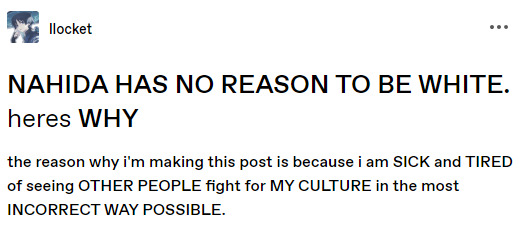
locket spread misinformation on that post because famous non-muslim non-indian tiktok user firestorm703934 said she's based off the moon (not saraswati who has the godly glow of the moon, just the moon itself because that makes so much sense for the god of dendro and wisdom to be based off the moon itself) on a post where an artist drew nahida with melanin


as you see in this comment, they're totally right about their point, the moon ISN'T tan. therefore nahida shouldn't be "tan" either, it's perfect logic

2. sent me cryptic death threats
locket would sometimes send me messages that i don't understand, so i put them through in google translate and you will never believe what they said

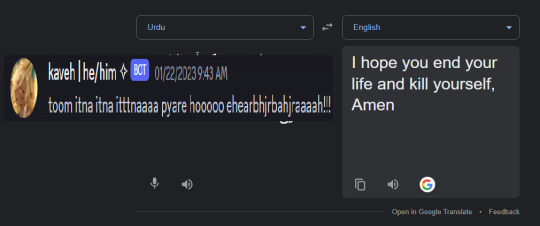
this was really hurtful. i cried for days on end after google translating this.

3. cultural appropriation
locket speaks urdu, but they have multiple parts with names of different languages

as you can see here kaveh is a PERSIAN name. not URDU.

and here, kaeya is an INDIAN name. not URDU.
also, one of his parts used a language thats NATIVE TO INDIA (NOT URDU.) symbol as an aesthetic in their intro.

(urdu is a mix of arabic, turkish and persian just so you know, and they are half indian half pakistani, they can use all of these)

4. he was previously RCTA
from 2015~2022 locket claimed to be a different race, he claimed to be canadian and white, not half pakistani and half indian.
proof:

this is from their old carrd from 3 years ago claiming that they're white


here they are seen PHOTOSHOPPING THEIR SKIN to be another race, like wow, why would you do this to yourself? that's so fucking insane
this is their REAL HAND in comparison:


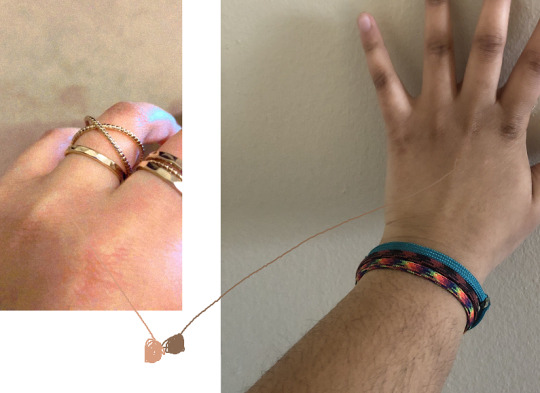
THIS IS SICK. ^
they've also made their roblox avatar white back in 2021 to trick me into thinking they're white:


his username is "J44KU", as you can see it's WHITE

5. copying my work
multiple times locket has purposfully copied my work. taking too heavy inspiration and then claiming it as their OWN.



here you see locket clearly copying my akira and ryo graphics i've made in december last year.

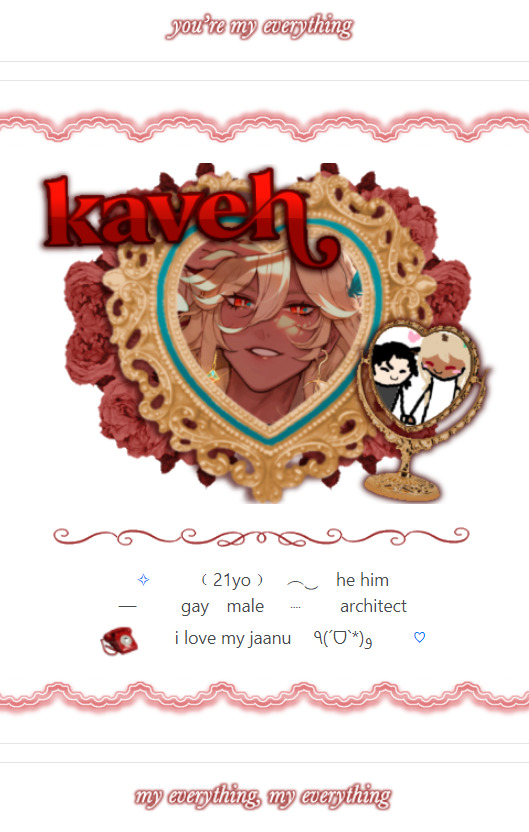
and here you see the CLEAREST COPY IN EXISTENCE. they copied everything about my part noir's rentry. it's SICK

TAGS: please spread the word.
@yaoitistic @hamusie @pwupsicle @venshuko @necroangelz @otoripink @mukurosgf @magnoliawriter @cactiflowering @triokoto
(PLEASE DONT TAKE THIS SERIOUSLY BY THE WAY, LOCKET WAS IN ON IT TOO AND GIVING ME IDEAS AND IMAGES!! please don't actually try cancel my boyfriend for this, this is all for shits and giggles, happy april fools!)

65 notes
·
View notes
Text

#choose Wisdom#bettertomorrows#goldennuggets#Serenity Unveiled#spirituality#faith#healing#indian men#native american woman rituals#mindfulness#inspiration#youtube
0 notes
Text
Hear me out everyone:
If, for any reason, we ever had to choose an animal symbol to represent the Rayllum couple, the chosen animal definetly should be the owl!


(To be honest, I first thought that as a joke, but i don't think i'm joking about this anymore)
Look, the owl is a nocturnal animal – wich would represent Rayla. And who also can fly swiftly and wonderfully – wich would represent Callum with the the sky arcanum.
But, I discovered later that some owl species often show affection, by "preening each other's feathers."
Wich reminded me of this custom of the Moonshadow Elves:

Also, the symbolism of the owl can change according to the culture. It can mean something good, or it can be a bad omen.
Below is a list of some of their symbologies – I asked the browser app to summarize some of them:
Wisdom and prophecy: The ancient Greeks and Romans associated owls with wisdom and prophecy. In Greek mythology, the owl is one of the symbols of the goddess Athena.
Spirituality: Owls are often seen as a connection to the spiritual world, perhaps because they are active at night.
Feminine power: Owls are associated with the feminine, the moon, and the night.
Ancient knowledge: In Native American Indian beliefs, owls symbolize ancient knowledge.
Bad luck: In many cultures, owls are considered to be a bad omen or sign of death. Some believe that bad luck will befall anyone who hears an owl hoot three times.
Destruction and desolation: In the Bible, owls symbolize destruction and desolation because they inhabit ruins and utter a hooting cry that sounds like a groan.
#the dragon prince#tdp#the mystery of aaravos#tdp spoilers#continuethesaga#giveusthesaga#tdp rayla#tdp callum#tdp rayllum#rayllum
26 notes
·
View notes
Text
hey, it's been a minute, but let's talk about dark academia that isn't as euro-centric cause i'm like, really sick of it lmfao
(also, i'm white and live in the US! people who aren't white and who don't live in the us, lemme know if there's anything I'm missing!)
yeah yeah, dark academia, learn a dead language. latin is good because of science, but have you ever considered learning arabic? lots of our math stuff comes from arabic and the scholars in the baghdad house of wisdom (hell, al-gebra)
or maybe learn sanskrit! like latin is an "academic language" in the west, sanskrit has similar connotations in the indian subcontinent, with many historical records having been written in sanskrit
hell, if we're talking liturgical languages like latin, why not try church slavonic or coptic?
please stop romanticizing only european architecture. its beautiful and stunning, and so is architecture from all over the world! just as a couple examples:
st michaels golden-domed monestary
the bibi-khanym mosque in Uzbekistan
the tomb of askia in gao, mali
machu picchu
the iron pagoda in Kaifeng, china
etc etc etc!!
read academia from all over the world!! there are scholars in india and china and kazakhstan and south africa with wonderful writing about their own histories and cultures, you just have to do a little google scholar search to find it!
look at oral histories and folklore from all over the world! like blue from osp said, if people consider the witcher (which is just medieval poland) as exotic, what will they do when they read gilgamesh or the monkey king? look at the wonderful parallels between our bodies of folklore and mythology and oral history, like the floods in the bible and in gilgamesh!
that being said, look for sources written BY the people who are telling these stories. outsiders have their own biases and agendas, so read anything about different cultures than the author (especially ones that no longer exist) critically and biographically. looking at you, snorri
be more chill about people with bodies that you dont think are normal. be more chill about people with bodies that you don't think should be wearing DA clothing, or that you think are doing it wrong. they have every right to wear DA clothing, and they're doing it better than you are.
understand that if you're in a position to be enjoying DA, you're probably privileged. use that privilege for good, fight for what is right, and listen to marginalized voices. if you fuck up, acknowledge that you fucked up and work to right the wrong and not do it again, but don't take someone telling you you fucked up as a personal attack. it's not.
i acknowledge that the land i live on was originally stewarded and lived upon by a native american tribe that no longer exists because of european colonization. i acknowledge their (and the tribe that survivors of the colonization in my area went to)'s right to the land.
#dark academia#academia#light academia#dark aesthetic#decolonialism#snorri sturluson#aesthetic#chaotic academia#disability#architecture
22 notes
·
View notes
Text
From the exhibition:
When creating certain aspects of Malevolent Shrine's design, Akutami Gege apparently referenced Daiitoku-myōō (大威徳明王) - a deity of Vajrayana Buddhism, known as the 'destroyer of death' and sometimes conceptualised as 'conqueror of the lord of death', and Gozu Tennō (牛頭天王) - a Japanese deity of disease and healing, who was regarded since the Heian period both as a causer of and protector against epidemics and eventually became merged with the native kami Susanoo.
First, let's take a look at Daiitoku-myōō:

He manifests in several different forms, one of which has six legs, six faces and six arms holding various weapons while sitting or standing on a water buffalo (sometimes depicted surrounded by flames). The topmost face is the wrathful aspect of Mañjuśrī (a bodhisattva who represents transcendent wisdom) with a red face below it. The other faces are yellow, dark blue, red, black, white, grey, and brown. Each face has three eyes. In Chinese Esoteric Buddhism and Shingon Buddhism, he is pictured with six faces, legs and arms holding various weapons while sitting on a white ox.
Now, let's look at Gozu Tennō:

Gozu Tennō was usually portrayed as a fierce-looking man with the head of an ox above his head. He is sometimes shown wielding an axe in one hand and a noose or lasso in the other, though other depictions may instead show him brandishing a sword or a halberd. He may be clad either in Indian-style garments, a suit of armor, or in Japanese Heian period clothing. Some artworks might depict the deity with multiple arms and heads: a late Heian period statue in Sakai, Osaka Prefecture for instance shows him with three faces and four arms. Another statue in Tsushima, Aichi Prefecture depicts him with twelve arms, four heads (two fierce human heads each with a single horn, a horse's head, and an ox's head), and bird talons for feet.
I think the aspects Akutami Gege took from these two figures when depicting Sukuna inside his innate domain and creating Malevolent Shrine are quite clear and this new information from the exhibition does give us a better insight behind the creation of his character.
#akutami gege~~~ well done once again when it comes to sukuna.#there is so much more i want to say on the connection between these two figures and sukuna but...#for now this will do...#sukuna#jjk sukuna#sukuna ryomen#ryomen sukuna#ryoumen sukuna#jjk#jujutsu kaisen
30 notes
·
View notes
Text
Equity Education and Mutual Justice Resources: The List
Books (most have an audiobook form)
Anti-Racism and Intersectionality How to Be an Antiracist by Ibram X. Kendi
Darkwater: Voices from Within the Veil by W.E.B. Du Bois On Critical Race Theory: Why It Matters & Why You Should Care by Victor Ray
You Are Your Best Thing: Vulnerability, Shame Resilience, and the Black Experience by Tarana Burke (Editor) Brené Brown (Editor) Stamped from the Beginning: The Definitive History of Racist Ideas in America by Ibram X. Kendi
So You Want to Talk About Race By Ijeoma Oluo
Between the World and Me by Ta-Nehisi Coates
I'm Still Here: Black Dignity in a World Made for Whiteness by Austin Channing Brown
Sister Outsider: Essays and Speeches by Audre Lorde
Raising White Kids: Bringing Up Children in a Racially Unjust America by Jennifer Harvey
Why I'm No Longer Talking to White People about Race by Reni Eddo-Lodge
The Undocumented Americans by Karla Cornejo Villavicencio
Mutual Aid, Direct Action, Organizing, and Community Building
Let This Radicalize You: Organizing and the Revolution of Reciprocal Care by Mariame Kaba and Kelly Hayes
Just Action: How to Challenge Segregation Enacted Under the Color of Law by Richard Rothstein and Leah Rothstein
Mutual Aid: Building Solidarity During This Crisis (and the Next) by Dean Spade
Mutual Aid: A Factor of Evolution by Pyotr Kropotkin
Living at the Edges of Capitalism: Adventures in Exile and Mutual Aid by Andrej Grubačić
Viral Justice: How We Grow the World We Want by Ruha Benjamin
We Do This 'til We Free Us: Abolitionist Organizing and Transforming Justice by Mariame Kaba
Practicing Cooperation: Mutual Aid beyond Capitalism by Andrew Zitcer
Practicing New Worlds: Abolition and Emergent Strategies by Andrea Ritchie Anti-Capitalist and Anti-Colonialism Education
The Poverty of Growth by Olivier De Schutter
Becoming Abolitionists: Police, Protests, and the Pursuit of Freedom by Derecka Purnell, Karen Chilton, et al.
The Future Is Degrowth: A Guide to a World Beyond Capitalism by Aaron Vansintjan, Matthias Schmelzer, and Andrea Vetter
Except for Palestine: The Limits of Progressive Politics by Marc Lamont Hill, Mitchell Plitnick, et al.
Anthropocene or Capitalocene? Nature, History, and the Crisis of Capitalism by Elmar Altvater (Author), Eileen C. Crist (Author), Donna J. Haraway (Author), Daniel Hartley (Author), Christian Parenti (Author), Justin McBrien (Author), Jason W. Moore (Editor) (Also available as a PDF online)
Dying for Capitalism: How Big Money Fuels Extinction and What We Can Do About It by Charles Derber, Suren Moodliar History and Political Science
A People's History of the United States by Howard Zinn
The Color of Law: A Forgotten History of How Our Government Segregated America by Richard Rothstein
Palestine: A Socialist Introduction by Sumaya Awad (Editor) and Brian Bean (Editor)
The New Jim Crow: Mass Incarceration in the Age of Colorblindness by Michelle Alexander (this technical book also has an organizing guide and study guide)
1491: New Revelations of the Americas Before Columbus by Charles C. Mann
Time's Monster: How History Makes History by Priya Satia
Indigenous Knowledge
Braiding Sweetgrass: Indigenous Wisdom, Scientific Knowledge and the Teachings of Plants by Robin Wall Kimmerer (there is also a version of Braiding Sweetgrass for young adults)
Becoming Kin: An Indigenous Call to Unforgetting the Past and Reimagining Our Future by Patty Krawec
Indian Givers: How Native Americans Transformed the World by Jack Weatherford
Tending the Wild: Native American Knowledge and the Management of California's Natural Resources by Kat Anderson
Fresh Banana Leaves: Healing Indigenous Landscapes Through Indigenous Science by Jessica Hernandez Disability Education and Rights Demystifying Disability: What to Know, What to Say, and How to Be an Ally by Emily Ladau Black Disability Politics by Sami Schalk
Crip Kinship: The Disability Justice & Art Activism of Sins Invalid by Shayda Kafai
Pandemic Solidarity: Mutual Aid during the Coronavirus Crisis by Marina Sitrin (Editor), Rebecca Solnit (Editor)
Disability Intimacy: Essays on Love, Care, and Desire by Alice Wong
The Future Is Disabled: Prophecies, Love Notes, and Mourning Songs by Leah Lakshmi Piepzna-Samarasinha
Refusing to Be Made Whole: Disability in Black Women's Writing by Anna Laquawn Hinton
Unmasking Autism: Discovering the New Faces of Neurodiversity by Devon Price (this author also has a guide on the same topic: Unmasking for Life: The Autistic Person's Guide to Connecting, Loving, and Living Authentically)
Queer Issues
We Are Everywhere: Protest, Power, and Pride in the History of Queer Liberation Hardcover by Matthew Riemer and Leighton Brown Transgender History: The Roots of Today's Revolution by Susan Stryker
Transgender Warriors: Making History from Joan of Arc to Dennis Rodman by Leslie Feinberg
Stonewall: The Definitive Story of the LGBTQ Rights Uprising That Changed America by Martin Duberman
Beyond the Gender Binary by Alok Vaid-Menon
Gender Queer: A Memoir by Maia Kobabe (graphic novel) Refusing Compulsory Sexuality: A Black Asexual Lens on Our Sex-Obsessed Culture by Sherronda J Brown
A Queer History of the United States by Michael Bronski
The Gay Agenda: A Modern Queer History & Handbook by Ashley Molesso and Chessie Needham
They/Them/Their: A Guide to Nonbinary and Genderqueer Identities by Eris Young
Gender Outlaws: The Next Generation by Kate Bornstein and S. Bear Bergman
This Book Is Gay by Juno Dawson (Author) and David Levithan (Contributor)
Nonbinary For Beginners: Everything you’ve been afraid to ask about gender, pronouns, being an ally, and black & white thinking by Ocean Atlas
All Boys Aren't Blue: A Memoir-Manifesto by George M. Johnson
Gender: A Graphic Guide by Meg-John Barker and Jules Scheele (Illustrator)
Resources for Kids and Parents
The Every Body Book: The LGBTQ+ Inclusive Guide for Kids about Sex, Gender, Bodies, and Families by Rachel E. Simon (Author) and Noah Grigni (Illustrator)
Braiding Sweetgrass for Young Adults: Indigenous Wisdom, Scientific Knowledge, and the Teachings of Plants by Monique Gray Smith (Author), Robin Wall Kimmerer (Author), and Nicole Neidhardt (Illustrator)
This Is a Book for Parents of Gay Kids: A Question & Answer Guide to Everyday Life by Dan Owens-Reid and Kristin Russo This Book Is Feminist: An Intersectional Primer for Next-Gen Changemakers by Jamia Wilson and Aurelia Durand (Illustrator)
Unlearning White Supremacy and Colonialist Culture
The Body Is Not an Apology: The Power of Radical Self-Love by Sonya Renee Taylor
Rest Is Resistance: A Manifesto by Tricia Hersey
White Fragility: Why It's So Hard for White People to Talk about Racism by Robin Diangelo
Black Rage by William H. Grier and Price M. Cobbs
White Rage: The Unspoken Truth of Our Racial Divide by Carol Anderson
How to Understand Your Gender: A Practical Guide for Exploring Who You Are by Alex Iantaffi and Meg-John Barker
This Book Is Anti-Racist: 20 Lessons on How to Wake Up, Take Action, and Do the Work by Tiffany Jewell (Author) and Aurelia Durand (Illustrator)
Redefining Realness: My Path to Womanhood, Identity, Love & So Much More by Janet Mock
Gender Trauma: Healing Cultural, Social, and Historical Gendered Trauma by Alex Iantaffi
The Politics of Trauma: Somatics, Healing, and Social Justice by Staci Haines
Brainwashed: Challenging the Myth of Black Inferiority by Tom Burrell
Me and White Supremacy: Combat Racism, Change the World, and Become a Good Ancestor by Layla F. Saad
Articles and Online Resources (Including Research Articles)
White Supremacy Culture by Tema Okun, at dRworks (This is a list of characteristics of white supremacy culture that show up in our organizations and workplaces.)
Reflections on Agroecology and Social Justice in Malwa-Nimar by Caroline E. Fazli
Mutual Aid Toolbox by Big Door Brigade Mutual Aid Resources by Mutual Aid Disaster Relief No body is expendable: Medical rationing and disability justice during the COVID-19 pandemic by Andrews, Ayers, Brown, Dunn, & Pilarski (2021)
Poisoning the World for Profit: Petro-Chemical Capital and the Global Pesticide Crisis by Daniel Faber
A Marxist Theory of Extinction by Troy Vettese
Agroecology and food sovereignty: charting a way to a radical transformation of the food system with Michel Pimbert and Tomáš Uhnák in Conversation
From Sustainable Agriculture to Sustainable Agrifood Systems: A Comparative Review of Alternative Models by Qian Forrest Zhang Intersectionality Research for Transgender Health Justice: A Theory-Driven Conceptual Framework for Structural Analysis of Transgender Health Inequities by Linda M. Wesp, Lorraine Halinka Malcoe, Ayana Elliott, and Tonia Poteat Know Your Rights Guide to Surviving COVID-19 Triage Protocols by NoBody is Disposable
Masks and respirators for prevention of respiratory infections: a state of the science review by Trisha Greenhalgh, C. Raina MacIntyre, Michael G. Baker, Shovon Bhattacharjee, Abrar A. Chughtai, David Fisman, Mohana Kunasekaran, Joe Vipond Finally Feeling Comfortable: The Necessity of Trans-Affirming, Trauma-Informed Care by Alex Petkanas (on TransLash Media)
'Are you ready to heal?': Nonbinary activist Alok Vaid-Menon deconstructs gender by Jo Yurcaba
Gender-affirming Care Saves Lives by Kareen M. Matouk and Melina Wald
What It Takes to Heal: How Transforming Ourselves Can Change the World by Prentis Hemphill

Note from the curator: These are in no particular order. I've found these resources serve as primers and/or ways to dive into these topics that are essential for social justice reform and growing the world we want to see. My own background is in agriculture/food/ecology, transgender justice, and disability activism so I hope folks with recommendations and expertise in other areas will reach out so I can add to this list. Please use your local libraries when possible! Be #ResiliencePunk.
#Free Palestine#Anticapatalist#ResiliencePunk#Disability Justice#Food Justice#Mutual Aid#Resource List#Recommended Books#Disability#Social Justice#Anti Colonization#Black Rights#Agroecology#Queer History
7 notes
·
View notes
Text
What is the significance of the ninth house in a birth chart?
The 9th house in a birth chart is highly significant and is often associated with luck, wisdom, and higher purposes. Here are for key points about its importance:
House of Fortune and Luck: The 9th house is considered the "house of fortune" (Bhagya Sthana). It reflects one's luck, blessings, and opportunities in life. A strong 9th house can indicate good fortune, success, and the ability to overcome obstacles through grace or divine intervention.
Higher Learning and Philosophy: This house governs higher education, wisdom, philosophy, and spiritual beliefs. It represents one's quest for knowledge beyond the material world, such as religion, ethics, and a deeper understanding of life. It's the house of teachers, gurus, and mentors who guide the native.
Long-distance Travel and Exploration: The 9th house rules long journeys, both physical and metaphorical. It is associated with international travel, exploration, and cultural exchange, as well as the expansion of one’s horizons through these experiences.
Results of 9th House in Birth Chart: If you want to know about your Kundli then you can use Kundli Chakra Professional 2022 software which can give you better information like Kundli . Match Making ,K.P. System ,S.P.S. System, Jaimini System Ho ,rari (Prashna) Analysis Numerology - Predictions Numerology - Compatibility with partner and calculations Lal Kitab Analysis Lal Kitab Varshphal Analysis Muhurta Analysis Sarvato Bhadra Chakra - Ancient Indian method for predictions using Vedhas Nomenclature - Vedic method Nomenclature - Western method Transit study with various worksheets and animated transits Transit graph for financial astrologers Transit wheel (Detailed chart wheel with nakshatras and all aspects) is also used in western astrology Time correction can also be known about the study of events.
#astrology#astro observations#numerology#astro community#aries horoscope: star sign dates#birth chart#12th house#astrologer#cancer horoscope: star sign dates#8th house#aries weekly horoscope: what your star sign has in store for october 1 – 7#capricorn horoscope: star sign dates#capricorn weekly horoscope: what your star sign has in store for november 5 – 11#gemini horoscope: star sign dates#gemini weekly horoscope: what your star sign has in store for november 19 25#gemini weekly horoscope: what your star sign has in store for october 22 – 28#horoscope today#leo horoscope: star sign dates#libra horoscope: star sign dates#horoscope#andrew horowitz#horoskop
10 notes
·
View notes